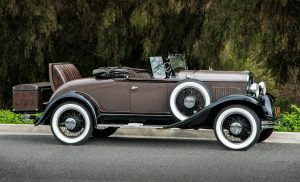Quick Links
What is Classic and Antique Car Transport?
Benefits of Classic and Antique Car Transport
How Does Classic and Antique Car Transport Work?
Who Uses Classic and Antique Car Transport?
Open vs. Enclosed Classic Car Transport
Pros and Cons of Classic and Antique Car Transport
Frequently Asked Questions About Classic and Antique Car Transport
Classic and Antique Car Transport

Classic and antique car transport is a specialized vehicle shipping service designed to protect and preserve the integrity of valuable, vintage automobiles during transit. Whether you’re relocating a prized car to your home, showcasing it at a car show, or selling it to a collector, this service ensures that your classic or antique vehicle arrives in pristine condition. With tailored options like enclosed carriers, expert handling, and white-glove service, classic car transport provides peace of mind for vehicle owners.
What is Classic and Antique Car Transport?
Classic and antique car transport focuses on safely and securely shipping high-value, vintage, or collectible vehicles. Unlike standard auto transport, this service utilizes specialized equipment, enclosed trailers, and experienced handlers to protect cars from weather, debris, and potential damage. It is ideal for owners of restored classics, vintage collectibles, and one-of-a-kind cars that require extra care.
Benefits of Classic and Antique Car Transport
Classic car transport provides significant advantages for vehicle owners:
- Maximum Protection: Enclosed trailers shield your car from external elements like weather, dust, and road debris.
- Expert Handling: Professional carriers have experience securing and transporting vintage and high-value cars safely.
- Preservation: Prevents wear and tear from long road trips, preserving the car’s condition and value.
- Comprehensive Insurance: Shipping includes insurance coverage for added peace of mind.
- Specialized Services: Options like climate-controlled trailers and white-glove handling cater to unique vehicles with specific needs.
How Does Classic and Antique Car Transport Work?
The process is tailored to ensure the safety and protection of your classic or antique car:
- Request a Quote: Provide details about your vehicle, pickup and delivery locations, and specific requirements, like enclosed transport.
- Choose Your Transport Option: Select enclosed transport for optimal protection. Climate-controlled carriers may also be available for sensitive vehicles.
- Schedule Pickup and Delivery: Work with the transport company to schedule a timeline that meets your needs.
- Prepare Your Car: Clean the vehicle, document its condition with photos, and remove any loose or personal items.
- Vehicle Pickup: The transporter will load your car using specialized equipment such as hydraulic lift gates and soft straps to prevent damage.
- In Transit: Your car will be shipped securely, with tracking or updates available to monitor its progress.
- Vehicle Delivery: Upon arrival, inspect the car to ensure it is in the same condition as when it was picked up.
Who Uses Classic and Antique Car Transport?
This service is ideal for anyone needing secure transport for high-value vehicles:
- Collectors: Shipping vehicles between private collections or to storage facilities.
- Car Show Enthusiasts: Ensuring vehicles arrive in show-ready condition for competitions.
- Auction Buyers and Sellers: Transporting cars to or from auctions without risking damage.
- Restoration Shops: Moving vehicles to and from specialists for restoration or repairs.
- Private Owners: Relocating classic cars for moves or temporary storage.
Open vs. Enclosed Classic Car Transport
Open Transport:
- Pros: Cost-effective for standard vehicles.
- Cons: Exposes cars to weather, debris, and potential damage.
- When to Use: Typically not recommended for classic or antique cars.
Enclosed Transport:
- Pros: Maximum protection from external elements and potential damage.
- Cons: Higher cost compared to open transport.
- When to Use: Ideal for classic, antique, or high-value vehicles requiring extra care.
Pros and Cons of Classic and Antique Car Transport
Pros:
- Enhanced Protection: Enclosed carriers safeguard against weather and debris.
- Professional Care: Experienced handlers ensure secure loading and unloading.
- Tailored Options: Climate control and white-glove services for specialized needs.
- Peace of Mind: Insurance coverage included with transport.
Cons:
- Higher Cost: Premium services, such as enclosed transport, are more expensive.
- Advance Booking Needed: Availability may be limited during peak seasons or for specialized equipment.
Frequently Asked Questions About Classic and Antique Car Transport
1. Is enclosed transport necessary for classic cars?
Yes, enclosed transport is strongly recommended for classic and antique cars to protect them from weather, debris, and potential damage.
2. How should I prepare my classic car for transport?
Clean your vehicle, remove any personal items, check for pre-existing damage, and document its condition with photos before shipping.
3. How much does classic car transport cost?
The cost varies based on factors like distance, type of carrier (enclosed vs. open), and the vehicle’s specifications. Enclosed transport is generally more expensive.
4. Is my car insured during transport?
Yes, professional transport companies include insurance coverage for vehicles. Confirm the details with your provider.
5. Can I track my car during transit?
Yes, most carriers provide tracking options or regular updates to keep you informed.
Final Thoughts on Classic and Antique Car Transport
Classic and antique car transport is the safest and most reliable way to move your high-value vehicle. Whether you’re shipping a vintage car for a show, relocating a collectible, or protecting an heirloom, professional transport services provide peace of mind with expert handling, enclosed carriers, and tailored solutions.
Contact us today for a free quote and let us help you transport your classic or antique car securely and efficiently.
